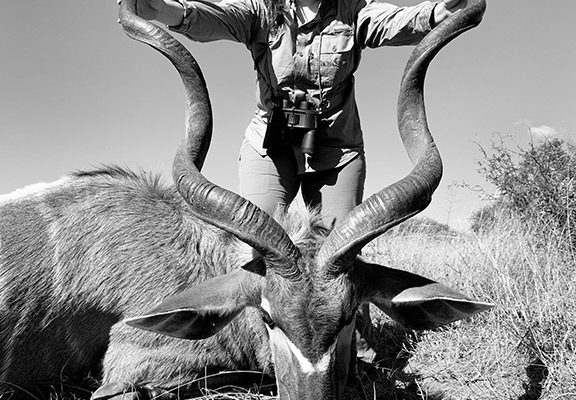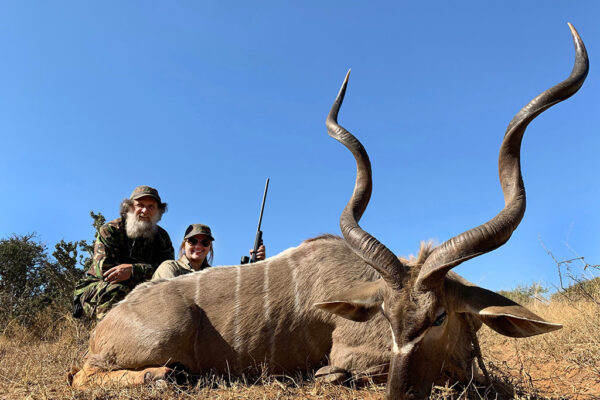Legally blind huntress takes a kudu
I have had a love for the outdoors and a passion for trophy hunting for all of my 21 years. Trophy hunting is a bit different for me, however, because I face the obstacle of being legally blind and completely colorblind. Being completely colorblind makes hunting difficult because I won’t always see the animal first. I can spot movement pretty quickly, but I have to use binoculars to determine what exactly it is I’m looking at. Usually I will limit myself to shoot about 100 yards just because that’s what I am comfortable with. I will have someone with me to help watch which direction an animal will run after a shot.
Last summer, I decided to go out on a limb way beyond my comfort zone. I took an opportunity to go on a plains game hunt in South Africa. I was very excited for this trip, although I was pretty scared at the same time. I had never hunted with people besides my family who knew my obstacles, my comfort zones, and my limits when it came to hunting.
Hunting in South Africa is all spot-and-stalk style. There was a lot to consider when coming into this being legally blind. First of all, I’m clumsy. So, watching my feet and cautiously stepping while hiking through the Africa bushveld was a task in itself.
Second, when doing spot-and-stalk you have to be aware of your surroundings. These animals have no reason to stick around. If they spot you or if they’re suspicious, they’re gone. You have to keep yourself aware with what you’re watching and what’s watching you in order not to spook anything.
Third, I was afraid I wouldn’t be able to spot something in the scope fast enough. When scanning with a scope, it’s difficult for me to see if something isn’t moving. If something is just standing still, I can scan right over it because the colors may blend into the surroundings. On top of my fears coming into this experience, I sprained my ankle while touring South Africa two days before I was supposed to hunt. But I didn’t sit on a 23-hour flight to come to South Africa and not take my opportunity to hunt.
I had my sights set on a spot-and-stalk for a kudu bull. I explained my situation to Mark Ivy, the owner of Ivy Safaris, and he decided to guide me himself. We set out at 6 a.m. the very next morning. That day we walked for 8 miles through the bush.
We had a few close calls, but I couldn’t spot the animal inside the scope fast enough before it spotted us. The next morning, we set out bright and early again to hopefully shoot my kudu bull. We trekked in and out of creeks and tall grasses and we would get very close to a few. But by the time we got set up, they would move along.
On the third morning of my four-day hunt, I came to Mark and told him about a couple more animals I would be willing to shoot if a kudu was too difficult, or if we came across those animals first. This day, I began to doubt myself. I wondered why I thought I could do such an intensive hunt, and why I thought this would be possible for me with my low vision. Soon after these thoughts flooded my head, we came across an impressive impala.
Because I had so many close calls before this, I was anxious. I just knew this animal would run off if I gave it time to do so. It could be another strike at my confidence as a hunter. I went against every bit of hunting ethic I was ever taught and I took an uncomfortable, rushed shot.
I completely missed, of course. As embarrassing as it was, I trekked behind Mark, tearing up, thinking I had flown to Africa just to come to the realization that I really can’t do everything I put my mind to because of my disability. I thought having another animal getting away was going to knock me down a peg, but missing an animal was even worse.
On the very last morning of my South Africa visit, I had no hope to shoot anything. But I added a couple more animals to my list for Mark so I could maximize my opportunity on the last day. As soon as we set out that morning, we came across a mature blesbok. I agreed to shoot it if I got the opportunity.
As expected, it took off as soon as we got near. Then suddenly, Mark took off. We were jogging through the bush and I was so worried I would trip or step in a hole and hurt my ankle some more. I wasn’t even looking up beyond Mark’s tracks.
He stopped to immediately set up the shooting sticks. He stood behind the sticks with his hand out behind him, giving me the “don’t move, we’re being watched” signal. I stood directly behind him, not even sure what we were looking at. He stepped to the side and nudged me towards the sticks.
I set up the rifle and began my process to find what we were looking at. He pulled the butt of the gun towards me and had me directly on the animal, then told me to shoot. It happened so fast, I didn’t have time to be anxious or doubt myself and my shooting abilities. I didn’t even have time to see what I was shooting at.
The way the sun had cast a shadow on the animal, I would’ve told you it was the blesbok. But as we went to track my trophy, one of the spotters said, “Congrats, you got your kudu bull that you came for.” I made a heart shot on a mature kudu bull at 160 yards—my farthest shot ever—after hiking 26 miles in 3 days on a sprained ankle. I wasn’t really sure how I pulled it off in the end. But if there’s anything I learned in the African bushveld, it’s that the greatest pleasure in life is doing what everyone, sometimes even yourself, believes you can’t do.




